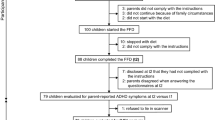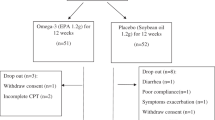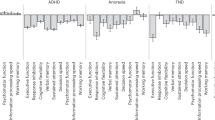Abstract
OBJECTIVE:
To explore the link between pediatric obesity and attention deficit/hyperactivity disorder (ADHD) by examining whether executive functioning (EF) and medication status are associated with body mass index (BMI) and weight status in children with ADHD.
METHOD:
Participants for this study included 80 children (mean age=10 years, 9 months) with a DSM-IV diagnosis of ADHD, confirmed by a comprehensive clinical diagnostic assessment. Children's EF was measured using three neuropsychological tests, and severity of ADHD symptoms and medication status were obtained from parent report. Children's height and weight were also measured during the visit using a wall-mounted stadiometer and a balance beam scale.
RESULTS:
Children with ADHD who performed poorly on the neuropsychological battery had greater BMI z-scores, and were more likely to be classified as overweight/obese compared with children with ADHD who performed better on the neuropsychological battery. In addition, children with ADHD who were taking a stimulant medication had significantly lower BMI z-scores compared with children with ADHD who were not taking medication or who were taking a non-stimulant medication.
CONCLUSION:
EF is more impaired among children with ADHD and co-occurring weight problems, highlighting the importance of self-regulation as a link between pediatric obesity and ADHD.
This is a preview of subscription content, access via your institution
Access options
Subscribe to this journal
Receive 12 print issues and online access
$259.00 per year
only $21.58 per issue
Buy this article
- Purchase on Springer Link
- Instant access to full article PDF
Prices may be subject to local taxes which are calculated during checkout
Similar content being viewed by others
References
Kuczmarski RJ, Ogden CL, Guo SS, Grummer-Strawn LM, Flegal KM, Mei Z et al. 2000 CDC growth charts for the United States: methods and development. Vital Health Stat 11 2002; 246: 1–190.
Ogden CL, Carroll MD, Curtin LR, McDowell MA, Tabak CJ, Flegal KM . Prevalence of overweight and obesity in the United States, 1999–2004. JAMA 2006; 295: 1549–1555.
Freedman DS, Khan LK, Serdula MK, Dietz WH, Srinivasan SR, Berenson GS . The relation of childhood BMI to adult adiposity: the Bogalusa Heart Study. Pediatrics 2005; 115: 22–27.
Hannon TS, Rao G, Arslanian SA . Childhood obesity and type 2 diabetes mellitus. Pediatrics 2005; 116: 473–480.
Lobstein T, Baur L, Uauy R . Obesity in children and young people: a crisis in public health. Obes Rev 2004; 5: 4–104.
Waring ME, Lapane KL . Overweight in children and adolescents in relation to attention-deficit/hyperactivity disorder: results from a national sample. Pediatrics 2008; 122: e1–e6.
Polanczyk G, Silva de Lima M, Horta BL, Biederman J, Rohde LA . The worldwide prevalence of ADHD: a systematic review and metaregression analysis. Am J Psychiatry 2007; 164: 942–948.
Akinbami LJ, Liu X, Pastor PN, Reuben CA . Attention deficit hyperactivity disorder among children aged 5–17 years in the United States, 1998–2009. NCHS data brief, no 70. National Center for Health Statistics: Hyattsville, MD, 2011.
Mash J, Barkley R (eds). Child psychopathology 2nd edn. Guilford: New York, NY, 2003.
Pagoto SL, Curtin C, Lemon SC, Bandini LG, Schneider KL, Bodenlos JS et al. Association between adult attention deficit/hyperactivity disorder and obesity in the US population. Obesity 2009; 17: 539–544.
ChenJ AY, Kim SE, Houtrow AJ, Newacheck PW . Prevalence of obesity among children with chronic conditions. Obesity 2010; 18: 210–213.
Curtin C, Bandini L, Perrin EC, Tybor DJ, Must A . Prevalence of overweight in children and adolescents with attention deficit hyperactivity disorder and autism spectrum disorders: a chart review. BMC Pediatrics 2005; 5: 48.
Holtkamp K, Konrad K, Müller B, Heussen N, Herpertz S, Herpertz-Dahlman B et al. Overweight and obesity in children with attention-deficit/hyperactivity disorder. Int J Obesity 2004; 28: 685–689.
Pauli-Pott U, Albayrak O, Hebebrand J, Pott W . Does inhibitory control capacity in overweight and obese children and adolescents predict success in a weight-reduction program? Eur Child Adolesc Psychiatry 2010; 19: 135–141.
Pauli-Pott U, Albayrak O, Hebebrand J, Pott W . Association between inhibitory control capacity and body weight in overweight and obese children and adolescents: dependence on age and inhibitory control component. Child Neuropsychol 2010; 16: 592–603.
Guerrieri R, Nederkoorn C, Jansen A . The interaction between impulsivity and a varied food environment: its influence on food intake and overweight. Int J Obes 2008; 32: 708–714.
Ptacek R, Kuzelova H, Paclt I, Zukov I, Fischer S . ADHD and growth: anthropometric changes in medicated and non-medicated ADHD boys. Med Sci Monit 2009; 15: 595–599.
Cortese S, MorcilloPenalver C . Comorbidity between ADHD and obesity: exploring shared mechanisms and clinical implications. Postgrad Med 2010; 122: 88–96.
Volkow ND, Wang GJ, Baler RD . Reward, dopamine and the control of food intake: implications for obesity. Trends Cogn Sci 2011; 15: 37–46.
Luman M, Oosterlaan J, Sergeant JA . The impact of reinforcement contingencies on AD/HD: a review and theoretical appraisal. Clin Psychol Rev 2005; 25: 183–213.
Volkow ND, Wang GJ, Fowler JS, Telang F, Maynard L, Logan J et al. Evidence that methylphenidate enhances the saliency of a mathematical task by increasing dopamine in the human brain. Am J Psychiatry 2004; 161: 1173–1180.
Wang GJ, Volkow ND, Logan J, Pappas NR, Wong CT, Zhu W et al. Brain dopamine and obesity. Lancet 2001; 357: 354–357.
Stice E, Spoor S, Bohon C, Small DM . Relation between obesity and blunted striatal response to food is moderated by TaqIA A1 allele. Science 2008; 322: 449–452.
Gearhardt AN, Yokum S, Orr PT, Stice E, Corbin WR, Brownell KD . Neural correlates of food addiction. Arch Gen Psychiatry 2011; 68: 808–816.
Volkow ND, Swanson JM . Does childhood treatment of ADHD with stimulant medication affect substance abuse in adulthood? Am J Psychiatry 2008; 165: 553–555.
Baumeister R, Vohs K (eds). Handbook of self-regulation: Research, theory, and applications. The Guilford Press: New York, USA, 2004.
Calkins SD . The emergence of self-regulation: Biological and behavioral control mechanisms supporting toddler competencies. In: Brownell C, Kopp C (eds). Socioemotional Development in the Toddler Years. The Guilford Press: New York, USA, 2007, pp 261–284.
Johnson SL, Birch LL . Parents’ and children's adiposity and eating style. Pediatrics 1994; 94: 653–661.
Nederkoorn C, Braet C, Van Eijs Y, Tanghe A, Jansen A . Why obese children cannot resist food: the role of impulsivity. Eat Behav 2006; 7: 315–322.
Francis LA, Susman EJ . Self-regulation and rapid weight gain in children from age 3 to 12 years. Arch Pediatr Adolesc Med 2009; 163: 297–302.
Seeyave DM, Coleman S, Appugliese D, Corwyn RF, Bradley RH, Davidson NS et al. Ability to delay gratification at age 4 years and risk of overweight at age 11 years. Arch Pediatr Adolesc Med 2009; 163: 303–308.
Graziano PA, Calkins SD, Keane SP . Toddler self-regulation skills predict risk for pediatric obesity. Int J Obes 2010; 34: 633–641.
Barkley RA . Behavioral inhibition, sustained attention, and executive functions: constructing a unifying theory of ADHD. Psychol Bull 1997; 121: 65–94.
Ellis LK, Rothbart MK, Posner MI . Individual differences in executive attention predict self-regulation and adolescent psychosocial behaviors. Ann NY Acad Sci 2004; 1021: 337–340.
Pennington BF, Ozonoff S . Executive functions and developmental psychopathology. J Child Psychol Psychiatry 1996; 37: 51–87.
Alexander MP, Stuss DT . Executive functions and the frontal lobes: a conceptual view. Psychol Res 2000; 63: 289–298.
Anderson P . Assessment and development of executive function during childhood. Child Neuropsychol 2002; 8: 71–82.
Boeka A, Lokken K . Neuropsychological performance of a clinical sample of extremely obese individuals. Arch Clin Neuropsychol 2008; 23: 467–474.
Gunstad J, Paul RH, Cohen RA, Tate DF, Spitznagel MB, Gordon E . Elevated body mass index is associated with executive dysfunction in otherwise healthy adults. Compr Psychiatry 2007; 48: 57–61.
Braet C, Claus L, Verbeken S, van Vlierberghe L . Impulsivity in overweight children. Eur Child Adolesc Psychiatry 2007; 16: 473–483.
Cserjési R, Molnár D, Luminet O, Lénárd L . Is there any relationship between obesity and mental flexibility in children? Appetite 2007; 49: 675–678.
Shaffer D, Fisher P, Lucas C . The Diagnostic Interview Schedule for Children (DISC). In: Hisenroth M, Segal D (eds). Comprehensive Handbook of Psychological Assessment 2nd edn. John Wiley & Sons: Hoboken, NJ, 2004, pp 256–270.
Conners K . Conners 3rd edition (Conners 3). Multi-Health Systems: Toronto, Canada, 2008.
Kuczmarski R, Ogden C, Guo S, Grummer-Straw L, Flegal K, Mei Z et al. CDC growth charts for the United States: Methods and development. Vital Health Statistics. Series 11, Vol. 246. National Center for Health Statistics: Hyattsville, MD, 2002, pp 1–90.
Delis DC, Kaplan E, Kramer JF . Delis-Kaplan Executive Function System. The Psychological Corporation: San Antonio, TX, 2001.
Swanson J, Greenhill L, Wigal T, Kollins S, Stehli A, Davies M et al. Stimulant-related reductions of growth rates in the PATS. J Am Acad Child Adolesc Psych 2006; 45: 1304–1308.
Swanson J, Elliott G, Greenhill L, Wigal T, Arnold A, Vitiello B et al. Effects of stimulant medication on growth rates across 3 years in the MTA Follow-up. J Am Acad Child Adolesc Psych 2007; 46: 1014–1026.
Poulton A, Cowell CT . Slowing of growth in height and weight on stimulants: a characteristic pattern. J Paediatr Child Health 2005; 39: 180–185.
Spencer TJ, Kratochvil CJ, Sangal RB, Saylor KE, Bailey CE, Dunn DW et al. Effects of atomoxetine on growth in children with attention-deficit/hyperactivity disorder following up to five years of treatment. J Child Adolesc Psychopharmacol 2007; 17: 689–700.
Dulcan M . Practice parameter for the assessment and treatment of children and adolescents with attention deficit hyperactivity disorder. J Am Acad Child Adolesc Psychiatry 2007; 46: 896–910.
Wood J, Crager J, Delap C, Heiskell K . Beyond methylphenidate: Nonstimulant medications for youth with ADHD. J Atten Disord 2007; 11: 341–350.
Cournot M, Marquie JC, Ansiau D, Martinaud C, Fonds H, Ferrières J et al. Relation between body mass index and cognitive function in healthy middle-aged men and women. Neurology 2006; 67: 1208–1214.
Lokken K, Boeka AG, Austin HM, Gunstad J, Harmon CM . Evidence ofexecutive dysfunction in extremely obese adolescents: a pilot study. Surg Obes Relat Dis 2009; 5: 547–552.
Johnson S, Birch L . Parents’ and children's adiposity and eating style. Pediatrics 1994; 94: 653.
Tremblay MS, Willms JD . Is the Canadian childhood obesity epidemic related to physical inactivity? Int J Obesity 2003; 27: 1100–1105.
Andersen R, Crespo C, Bartlett S, Cheskin L, Pratt M . Relationship of physical activity and television watching with body weight and level of fatness among children: results from the Third National Health and Nutrition Examination Survey. JAMA 1998; 279: 938–942.
Nigg JT, Willcutt EG, Doyle AE, Sonuga-Barke EJS . Causal heterogeneity in attention-deficit hyperactivity disorder: do we need neuropsychologically impaired subtypes? Biol Psychol 2005; 57: 1224–3010.
Willcutt EG, Doyle A, Nigg J, Faraone S, Pennington BF . Validity of the executive function theory of attention-deficit/hyperactivity disorder: A meta-analytic review. Biol Psychol 2005; 57: 1336–1346.
Finkelstein EA, Fiebelkorn IC, Wang G . State-level estimates of annual medical expenditures attributable to obesity. Obes Res 2004; 12: 18–24.
Pelham WE, Foster EM, Robb JA . The economic impact of attention-deficit/hyperactivity disorder in children and adolescents. J Pediatr Psychol 2007; 32: 711–727.
Pelham WE, Fabiano GA . Evidence-based psychosocial treatments for attention-deficit/hyperactivity disorder. J Clin Child Adolesc Psychol 2008; 37: 184–214.
Epstein LH, Valoski A, Wing RR, McCurley J . Ten-year outcomes of behavioral family-based treatment for childhood obesity. Health Psychol 1994; 13: 373–383.
Author information
Authors and Affiliations
Corresponding author
Ethics declarations
Competing interests
The authors declare no conflict of interest.
Rights and permissions
About this article
Cite this article
Graziano, P., Bagner, D., Waxmonsky, J. et al. Co-occurring weight problems among children with attention deficit/hyperactivity disorder: the role of executive functioning. Int J Obes 36, 567–572 (2012). https://doi.org/10.1038/ijo.2011.245
Received:
Revised:
Accepted:
Published:
Issue Date:
DOI: https://doi.org/10.1038/ijo.2011.245
Keywords
This article is cited by
-
Emotional problems mediate the association between attention deficit/hyperactivity disorder and obesity in adolescents
BMC Psychiatry (2023)
-
ADHD and Risk of Childhood Adiposity: a Review of Recent Research
Current Nutrition Reports (2021)
-
Attention-Deficit/Hyperactivity Disorder (ADHD) and Obesity: Update 2016
Current Psychiatry Reports (2017)



